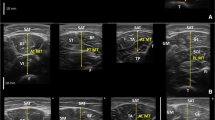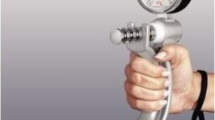Abstract
Purpose
There are only a few studies on the muscular strength of the foot in children and adolescents; thus, the developmental pattern and normative data of these populations during growth are unclear. We sought to elucidate the developmental pattern of the foot muscle strength among children, adolescents, and young adults compared with that of the hand.
Methods
A total of 747 children, adolescents, and young adults participated in this study, and their maximum isometric toe flexor strength (TFS), hand grip strength (HGS), and foot length were measured.
Results
TFS was correlated with HGS (r = 0.785), age (r = 0.659), height (r = 0.757), body mass (r = 0.737), and foot length (r = 0.594). Multiple regression analyses revealed that TFS was correlated with age (β = 0.243 in boys; β = 0.461 in girls), squared value of age (age2; β = − 0.296 in boys; β = − 0.260 in girls), and body mass (β = 0.256 in boys; β = 0.311 in girls) in both sexes, indicating a non-linear relationship between age and TFS development. In a regression model for HGS, age was a significant variable, but not age2. HGS increased linearly from childhood until young adulthood, whereas TFS increased from childhood until adolescence and then levelled off.
Conclusion
Our results demonstrate that TFS has a different developmental pattern compared with HGS.




Similar content being viewed by others
Abbreviations
- Age2 :
-
Squared value of age
- BM:
-
Body mass
- BM2 :
-
Squared value of body mass
- Height2 :
-
Squared value of height
- HGS:
-
Hand grip strength
- PHV:
-
Peak height velocity
- rHGS:
-
Relative hand grip strength
- rTFS:
-
Relative toe flexor strength
- TFS:
-
Toe flexor strength
References
Artero EG, Ruiz JR, Ortega FB, España-Romero V, Vicente-Rodríguez G, Molnar D, Gottrand F, González-Gross M, Breidenassel C, Moreno LA, Gutiérrez A, HELENA Study Group (2011) Muscular and cardiorespiratory fitness are independently associated with metabolic risk in adolescents: the HELENA study. Pediatr Diabetes 12:704–712
Bale P, Mayhew JL, Piper FC, Ball TE, Willman MK (1992) Biological and performance variables in relation to age in male and female adolescent athletes. J Sports Med Phys Fit 32:142–148
Beunen GP, Malina RM, Renson R, Simons J, Ostyn M, Lefevre J (1992) Physical activity and growth, maturation and performance: a longitudinal study. Med Sci Sports Exerc 24:576–585
Cornett KM, Menezes MP, Bray P, Halaki M, Shy RR, Yum SW, Estilow T, Moroni I, Foscan M, Pagliano E, Pareyson D, Laurá M, Bhandari T, Muntoni F, Reilly MM, Finkel RS, Sowden J, Eichinger KJ, Herrmann DN, Shy ME, Burns J, Inherited Neuropathies Consortium (2016) Phenotypic variability of childhood Charcot-Marie-Tooth disease. JAMA Neurol 73:645–651
Dimachkie MM, Barohn RJ (2014) Distal myopathies. Neurol Clin 32:817–842
Faul F, Erdfelder E, Buchner A, Lang AG (2009) Statistical power analyses using G*Power 3.1: tests for correlation and regression analyses. Behav Res Methods 41:1149–1160
Goldmann JP, Sanno M, Willwacher S, Heinrich K, Brüggemann GP (2013) The potential of toe flexor muscles to enhance performance. J Sports Sci 31:424–433
Häkkinen K, Keskinen KL (1989) Muscle cross-sectional area and voluntary force production characteristics in elite strength- and endurance-trained athletes and sprinters. Eur J Appl Physiol Occup Physiol 59:215–220
Hansen DM, Herrmann SD, Lambourne K, Lee J, Donnelly JE (2014) Linear/nonlinear relations of activity and fitness with children’s academic achievement. Med Sci Sports Exerc 46:2279–2285
Hicks J (1954) The mechanics of the foot. II. The plantar aponeurosis and the arch. J Anat 88:25–30
Ishihara T, Morita N, Nakajima T, Okita K, Yamatsu K, Sagawa M (2018) Direct and indirect relationships of physical fitness, weight status, and learning duration to academic performance in Japanese schoolchildren. Eur J Sport Sci 18:286–294
Jiménez-Pavón D, Ortega FB, Valtueña J, Castro-Piñero J, Gómez-Martínez S, Zaccaria M, Gottrand F, Molnár D, Sjöström M, González-Gross M, Castillo MJ, Moreno LA, Ruiz JR (2012) Muscular strength and markers of insulin resistance in European adolescents: the HELENA Study. Eur J Appl Physiol 112:2455–2465
Kelly LA, Cresswell AG, Racinais S, Whiteley R, Lichtwark G (2014) Intrinsic foot muscles have the capacity to control deformation of the longitudinal arch. J R Soc Interface 11:20131188
Ker RF, Bennett MB, Bibby SR, Kester RC, Alexander RM (1987) The spring in the arch of the human foot. Nature 325:147–149
Koyama K, Yamauchi J (2017) Altered postural sway following fatiguing foot muscle exercises. PLoS One 12(12):e0189184
Kura H, Luo ZP, Kitaoka HB, An KN (1997) Quantitative analysis of the intrinsic muscles of the foot. Anat Rec 249:143–151
Kurihara T, Yamauchi J, Otsuka M, Tottori N, Hashimoto T, Isaka T (2014) Maximum toe flexor muscle strength and quantitative analysis of human plantar intrinsic and extrinsic muscles by a magnetic resonance imaging technique. J Foot Ankle Res 7:26
Marquardt DW (1980) You should standardize the predictor variables in your regression models. J Am Stat Assoc 75:87–91
Maughan RJ, Watson JS, Weir J (1984) Muscle strength and cross-sectional area in man: a comparison of strength-trained and untrained subjects. Br J Sports Med 18:149–157
McKeon PO, Hertel J, Bramble D, Davis I (2014) The foot core system: a new paradigm for understanding intrinsic foot muscle function. Br J Sports Med 49:290
Morbeck ME, Zihlman AL (1988) Body composition and limb proportions. In: Schwarts J (ed) Orangutan biology. Oxford University Press, New York, pp 285–297
Morita N, Yamauchi J, Kurihara T, Fukuoka R, Otsuka M, Okuda T, Ishizawa N, Nakajima T, Nakamichi R, Matsuno S, Kamiie S, Shide N, Kambayashi I, Shinkaiya H (2014) Toe flexor strength and foot arch height in children. Med Sci Sports Exerc 47:350–356
Naka H, Iki M, Morita A, Ikeda Y (2005) Effects of pubertal development, height, weight, and grip strength on the bone mineral density of the lumbar spine and hip in peripubertal Japanese children: Kyoto kids increase density in the skeleton study (Kyoto KIDS study). J Bone Miner Metab 23:463–469
Newman DG, Pearn J, Barnes A, Young CM, Kehoe M, Newman J (1984) Norms for hand grip strength. Arch Dis Child 59:453–459
Ortega FB, Silventoinen K, Tynelius P, Rasmussen F (2012) Muscular strength in male adolescents and premature death: cohort study of one million participants. BMJ 345:e7279
Otsuka M, Yamauchi J, Kurihara T, Morita N, Isaka T (2015) Toe flexor strength and lower-limb physical performance in adolescent. Gazz Med Ital Arch Sci Med 174:307–313
Pagliano E, Moroni I, Baranello G, Magro A, Marchi A, Bulgheroni S, Ferrarin M, Pareyson D (2011) Outcome measures for Charcot-Marie-Tooth disease: clinical and neurofunctional assessment in children. J Peripher Nerv Syst 16:237–242
Philippaerts RM, Vaeyens R, Janssens M, Van Renterghem B, Matthys D, Craen R, Bourgois J, Vrijens J, Beunen G, Malina RM (2006) The relationship between peak height velocity and physical performance in youth soccer players. J Sports Sci 24:221–230
Ploegmakers JJ, Hepping AM, Geertzen JH, Bulstra SK, Stevens M (2013) Grip strength is strongly associated with height, weight and gender in childhood: a cross sectional study of 2241 children and adolescents providing reference values. J Phyiother 59:255–261
Quatman CE, Ford KR, Myer GD, Hewett TE (2006) Maturation leads to gender differences in landing force and vertical jump performance: a longitudinal study. Am J Sports Med 34:806–813
Tam N, Astephen Wilson JL, Noakes TD, Tucker R (2014) Barefoot running: an evaluation of current hypothesis, future research and clinical applications. Br J Sports Med 48:349–355
Thorpe SK, Crompton RH, Günther MM, Ker RF, McNeill Alexander R (1999) Dimensions and moment arms of the hind- and forelimb muscles of common chimpanzees (Pan troglodytes). Am J Phys Anthropol 110:179–199
Wind AE, Takken T, Helders PJ, Engelbert RH (2010) Is grip strength a predictor for total muscle strength in healthy children, adolescents, and young adults? Eur J Pediatr 169:281–287
Yamauchi J, Koyama K (2015) Influence of ankle braces on the maximum strength of plantar and toe flexor muscles. Int J Sports Med 36:592–595
Acknowledgements
We thank all children and teachers who cooperated with us for this study. The present study was partly supported by a Grant-in-Aid for Scientific Research (C; #22500619) for H. S.; for Young Scientists (B; #24700631 and # 23700688) for M.O., T.K, respectively; for Young Scientists (A; #23680066) for J.Y.; for Exploratory Research (#24650408) for J.Y. from the Ministry of Education, Culture, Sports, Science and Technology of Japan.
Author information
Authors and Affiliations
Contributions
All of authors satisfied the following area of authorship requirements: NM: manuscript writing, concept and study design, data acquisition, data analysis, and interpretation. JY: manuscript writing, concept and study design, data acquisition, data analysis, and interpretation. RF: concept and study design, data acquisition, data analysis, and interpretation. TK: concept and study design, data acquisition, data analysis, and interpretation. MO: concept and study design, data acquisition, data analysis, and interpretation. TO: concept and study design, data acquisition, data analysis, and interpretation. NS: concept and study design, data acquisition, data analysis, and interpretation. IK: concept and study design, data acquisition, data analysis, and interpretation. HS: concept and study design, data acquisition, and significant manuscript reviewer/reviser.
Corresponding author
Ethics declarations
Conflict of interest
The authors declare that they have no competing interest.
Additional information
Communicated by Guido Ferretti.
Rights and permissions
About this article
Cite this article
Morita, N., Yamauchi, J., Fukuoka, R. et al. Non-linear growth trends of toe flexor muscle strength among children, adolescents, and young adults: a cross-sectional study. Eur J Appl Physiol 118, 1003–1010 (2018). https://doi.org/10.1007/s00421-018-3827-x
Received:
Accepted:
Published:
Issue Date:
DOI: https://doi.org/10.1007/s00421-018-3827-x




